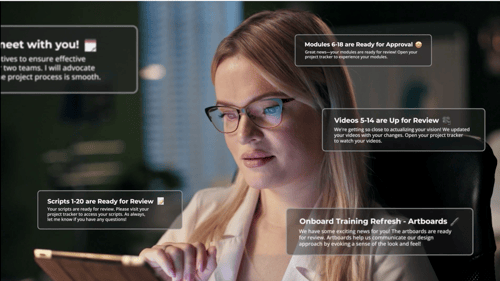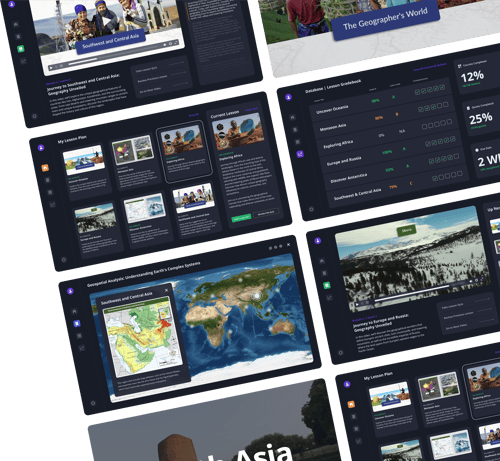We live in a world where information is just a click away, and learning can happen anywhere, anytime. As the digitization wave sweeps across the corporate world, traditional PowerPoint presentations and boring manuals are becoming relics of the past. So, what's the secret sauce for successful training in the modern age? The answer is simple: video.
Thanks to the rise of YouTube, videos have emerged as the superheroes of training tools and a go-to resource for learning. Let's explore how to effectively use quality training videos in the corporate world and understand how they can transform employee training.
What Exactly is an Employee Training Video?
Employee training videos are the digital equivalent of a seasoned mentor, a comprehensive textbook, and a lively classroom–all rolled into one. They're not just a mode of communication but a multifaceted tool that can transform abstract ideas into tangible knowledge. At their core, these educational videos empower employees with the information, skills, and attitudes they need to excel in their roles.
Think of employee training videos as personal tutors available at a click. Whether it's a new employee uncertain about company policies, or a seasoned professional upskilling to learn new software, training videos can cater to a diverse range of learning needs. Just as YouTube made training more accessible, streaming services have elevated our expectations for engaging, high-quality video. This means traditional teaching methods are tired and boring.
Employees now expect that corporate training video production uses elements of storytelling, animation, humor, and even interactive components to make learning an enjoyable journey rather than a tedious task.
Remember, at the end of the day, these are not just videos; your videos must reflect your company’s cultural standard, and they are key to making your employees feel confident and competent. Instructional videos transform an uncertain newbie into an informed professional, an apprehensive novice into a skillful specialist. They can instill company values, explain complex procedures, crystalize company policies, and provide step-by-step demonstrations.
An interesting example is how Google handled training for its global workforce. To standardize the training, they created a series of fun, animated training videos on various internal tools, marketing principles, and even industry practices. This not only ensured consistency of training but also allowed employees to revisit the modules whenever they needed a refresher.
Company training videos are also effective for onboarding remote employees, a common practice in the post-pandemic world. Remote workers might feel isolated without the usual office culture and face-to-face guidance. High-quality, engaging training videos can bridge this gap, making new employees feel included and well-guided.
Despite the clear benefits and growing popularity, there's a lingering myth that employee training video production is a herculean task, expensive and time-consuming. In reality, producing training videos can be a smooth and efficient process, provided you approach it with a clear strategy and the right resources. Whether you're a small business looking to train a handful of employees or a multinational corporation aiming to standardize training across continents, employee training videos can be powerful and cost-effective.
What Kinds of Employee Training Videos Are Common?
The beauty of training videos lies in their versatility. They can take various forms, each designed to meet specific training needs and engage different learning styles. Here are some of the common types of video:
-
Demo Videos: These videos visually guide viewers through a process, a task, or a product. For instance, when Apple rolls out a new product, it produces comprehensive demonstration videos illustrating the features and operations of the product. Employees can quickly learn about the new product, increasing their competence and confidence when interacting with customers.
-
Animated Explainers: These videos are fantastic for communicating complex concepts, data, or processes. For instance, the cybersecurity company Norton uses animated videos to explain intricate topics like internet privacy, malware, or VPNs. Animated videos break down these abstract concepts into visual, understandable components, making the learning process enjoyable and memorable.
-
Interactive Videos: Videos that include quizzes, interactive components, or even branching scenarios foster active learning and engagement. Codecademy, an online platform teaching coding skills, uses interactive videos where learners answer questions or solve problems based on the video content. This approach ensures active involvement from learners, promoting better retention and application of concepts.
-
Retail Training Videos: These videos are particularly valuable for retail employees. They can cover product knowledge, store procedures, sales techniques, and customer service etiquette. Starbucks, for instance, uses training videos to teach baristas how to make various coffee drinks, handle customer complaints, and maintain hygiene standards. This helps standardize service quality across stores worldwide.
-
Sales Training Videos: These are designed to train sales teams on techniques, product knowledge, and client handling. For example, HubSpot, a leading CRM platform, has an extensive library of sales training videos. These cover everything from the basic principles of inbound sales to complex negotiation strategies, role-play scenarios, and even product-specific sales techniques.
-
Client Training Videos: It's not just employees who can benefit from training videos; clients can too. By showing clients how to use your products or services, you can maximize their experience and satisfaction. For example, the cloud-based software company Salesforce has a platform called 'Trailhead', which features an array of videos that help clients understand and utilize their CRM software better.
By identifying the different learning needs of your audience, you can decide the type of instructional video that would best address those needs. Using a mix of these types can create a comprehensive and engaging learning program, catering to various learning styles and preferences. As technology continues to evolve, the possibilities for creative and effective training videos are practically limitless. It's an exciting time to be in the realm of employee training video production!
What are the Benefits of Producing These Kinds of Videos?
Employee training videos aren't just a trend; they are becoming a cornerstone of effective corporate training. They offer a slew of benefits that traditional training methods struggle to match. Here's how:
-
Cost Effective: Traditional training can be costly. Think about the expenses incurred in hiring a trainer, securing a venue, and in some cases, transporting the trainer or employees to the venue. A high-quality training video, once produced, is like a renewable resource. It can be used and reused, reaching an unlimited number of employees without additional costs. For instance, IBM reported saving $200 million after switching to e-learning, a significant portion of which involved video training.
-
Increased Retention: Visuals aid memory. According to the Social Science Research Network, 65% of people are visual learners. Dr. Lynell Burmark, a noted education consultant, points out that "unless our words, concepts, ideas are hooked onto an image, they will go in one ear, sail through the brain, and go out the other ear. Words are processed by our short-term memory, where we can only retain about seven bits of information. Images, on the other hand, go directly into long-term memory where they are indelibly etched." In essence, well-crafted training videos can boost retention rates dramatically.
-
Flexibility: The Netflix model of 'watch anything, anytime, anywhere' applies to training videos too. Whether your employees are early birds, night owls, or weekend warriors, training videos are available around the clock. They can be paused, rewound, or replayed, offering learners control over their learning pace. An Ernst & Young study found that for every hour of e-learning, nearly five hours of work time were saved, thanks to this flexibility.
-
Consistent Messaging: Ever played the 'Telephone' game where a message gets distorted as it passes from one person to the next? Traditional instructor-led training can sometimes mimic this game. However, with training videos, the information remains consistent, regardless of who is viewing it and when. This ensures uniformity of training across the organization, fostering equal opportunities for skill development.
-
Engaging: According to a study by the University of Minnesota, students rate instructors who use visual aids as more effective than those who do not. Videos, with their mix of visuals, sound, storytelling, and interactivity captivate attention and promote deeper understanding.
In summary, training videos are a smart investment. They deliver high-value training that's cost-effective, consistent, engaging, and tailored to the viewer's pace and convenience. The result? A more skilled, confident, and effective workforce. Now that's a win-win scenario!
What Are Some Tips for Making Good Employee Training Videos?
Creating engaging and effective training videos isn't rocket science, but it does require a strategic approach. Here are a few guiding principles, paired with real-world examples, to set you on the right path:
-
Understand Your Audience: Your training video will only resonate if it addresses the needs of your audience. Start by understanding who your viewers are, what they already know, and what they need to learn. By aligning the video content with the viewer's knowledge level and learning objectives, you can ensure that the video is valuable and relevant. As an example, Airbnb's host training videos differ significantly from its employee training videos as they cater to different audiences with different needs.
-
Keep It Short and Simple: Attention spans are shrinking, with a Microsoft study suggesting they might be as short as eight seconds! So, aim for brevity. Break down complex information into bite-sized pieces–this is known as “chunking”--which makes the content easier to digest and remember. TED Talks, renowned for their impactful content, rarely exceed 18 minutes. TED curator Chris Anderson explains, "It [18 minutes] is long enough to be serious and short enough to hold people's attention."
-
Make It Interactive: Do you want your instructional videos to be fun? Then make it interactive. Interactivity boosts engagement and reinforces learning. Consider including quizzes, interactive exercises, or even a 'choose your own adventure' style format. Duolingo, a language learning platform, incorporates interactive components in its videos, turning learning into a fun game.
-
Quality Matters: Poor video or audio quality can be distracting and can reflect poorly on your brand. Invest in high-quality production. A study from the University of British Columbia found that high-quality videos were rated more engaging than lower-quality ones, regardless of the content.
-
Review and Improve: Use viewer feedback and analytics to gauge the effectiveness of your videos. Are viewers dropping off at a particular point? Is there a quiz question that most viewers are getting wrong? Use this feedback loop to refine and improve your videos continually. YouTube's Creator Academy offers analytics to understand viewer behavior and adjust content accordingly.
Creating effective training videos is both a science and an art. It requires understanding your audience, creating concise and interactive content, investing in quality, and leveraging feedback. With these tips in mind, you'll be well on your way to crafting training videos that inform, engage, and inspire.
For more detailed tips, see: “From Snooze to Sizzle: 7 Tips to Boost Learning Video Engagement”
Ready to Get Started on Your Own Employee Training Video?
Embarking on your journey to create effective employee training videos is an exciting step. It's a move towards engaging, scalable, and effective learning experiences that can transform your workforce's skills and productivity levels. But where do you begin?
Firstly, take a deep breath. You don't need to be the Steven Spielberg of the corporate training world to create effective training videos. Companies like NextThought Studios are there to assist, providing full-service video production tailored to your organization's unique needs.
Why consider outsourcing? Apple is an excellent example. Known for its sleek product designs and innovative tech, you may be surprised to learn that Apple often outsources parts of its production process. Apple focuses on what they do best–design and innovation–and trusts external experts for specific components, like the processors or camera lenses. It's a practical strategy that can also apply to your training video production. By entrusting the task to video production experts who have created thousands of engaging training videos for organizations across the world, you can concentrate on what you do best–running your organization or team.
Whether it's an animated explainer video breaking down the intricacies of your latest product, an interactive video that transforms a complex training manual into an engaging quiz show, or a series of short videos that offer on-demand training on critical soft skills, NextThought Studios can bring your vision to life. Chances are you already have an idea of the style for your instructional videos.
Review NextThought’s training video production work and styles.
Our training video production services are creative, streamlined, and efficient, which saves you both time and resources. Whether you need to create one or 100 videos, we’ve perfected the process that has helped brands like Amazon, Airbnb, and Encyclopedia Britannica educate their audience.
So, if you're ready to transform your organization's learning landscape, let's start creating! Don't underestimate the power of well-crafted training videos. After all, as film producer Frank Capra once said, "There are no rules in filmmaking. Only sins. And the cardinal sin is dullness." So, let's banish dullness from our training and foster a culture of continuous learning and improvement.
How important is training to you? Reach out today, and together we can craft training videos that are far from a sin, but rather a saving grace for your learners.

NextThought team
NextThought transforms workplace learning through creative technology and engaging media. We're fortunate to partner with some of the top organizations in the world to make their educational training content remarkable and effective.
Recent Posts

What Can Go Wrong With A Custom Training Project? (And How NextThought Makes It Go Right)
August 5, 2025 1 Min Read

How Much Does a Custom Content Development Project Cost?
July 9, 2025 3 Min Read

The 6 Best Educational Video Production Companies (2025)
February 28, 2025 9 Min Read
